Erecting the Monument
1925. – 1935.
The celebration of the millennial history of the Kingdom of Croatia gave the main impulse to the idea of putting up a monument to the first king of Croatia. The initiator was the Zagreb lawyer Dr Milan Dečak, who founded the Committee for the Erection of a Monument to King Tomislav, using it a platform for the sourcing of funds for the project. The Committee was officially founded in 1924, and in 1925 all the departments of the committee came to life (artistic, journalistic, financial, economic), the Regulations were announced and a start was made on putting into practice everything that had been conceived. Robert Frangeš Mihanović headed the art section, and it was to him that the role of creator of the monument was given. Frangeš Mihanović imagined the monument on the southern side of what was once I Square, in front of the Zagreb Main Railway Station, in the same place where in 1905 Viktor Kovačić had foreseen a seated sculpture of Franz Joseph I. The positive atmosphere in politics arising from the celebration of the Croatian Millennium was repeated in the feeling of the Committee and on December 31, 1925, a foundation stone for the monument was consecrated and placed in the treasury of Zagreb Cathedral for safekeeping. The idea to raise a monument was supported in the media and there were increasing numbers of articles in the papers highlighting the Croatian past and the regrettable paucity of important people from Croatian history in the names of the squares and streets. In 1927, accordingly, in expectation of the monument, I Square was renamed King Tomislav Square. In the same year the Committee became the Society for the Erection of a Monument to King Tomislav.
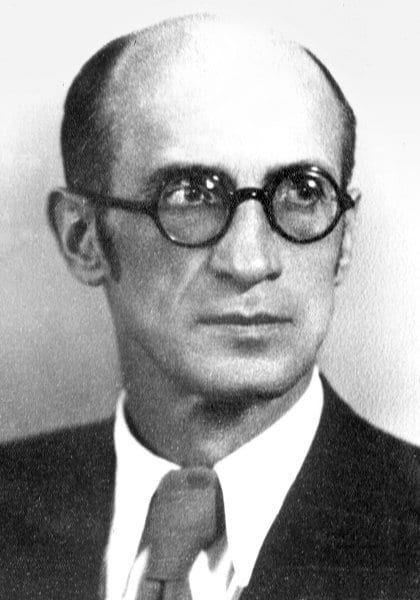
dr. Milan Dečak (1883.-1968.)
AAt the same time the idea to arrange a Millennium Museum on the same square was born; it would exhibit Old Croatian monuments, the concern for which would be headed, within the Society, by Viktor Hoffiller, an archaeologist. This idea was relinquished in 1932, as a result of lack of funding and also because the original monuments were not allowed to be moved to Zagreb, while plaster casts could not be shown outdoors. Plaster casts started being made in 1928, and after the Millennium Museum was abandoned some of them were stored in the Croatian Academy of Sciences and Arts Gliptoteka.
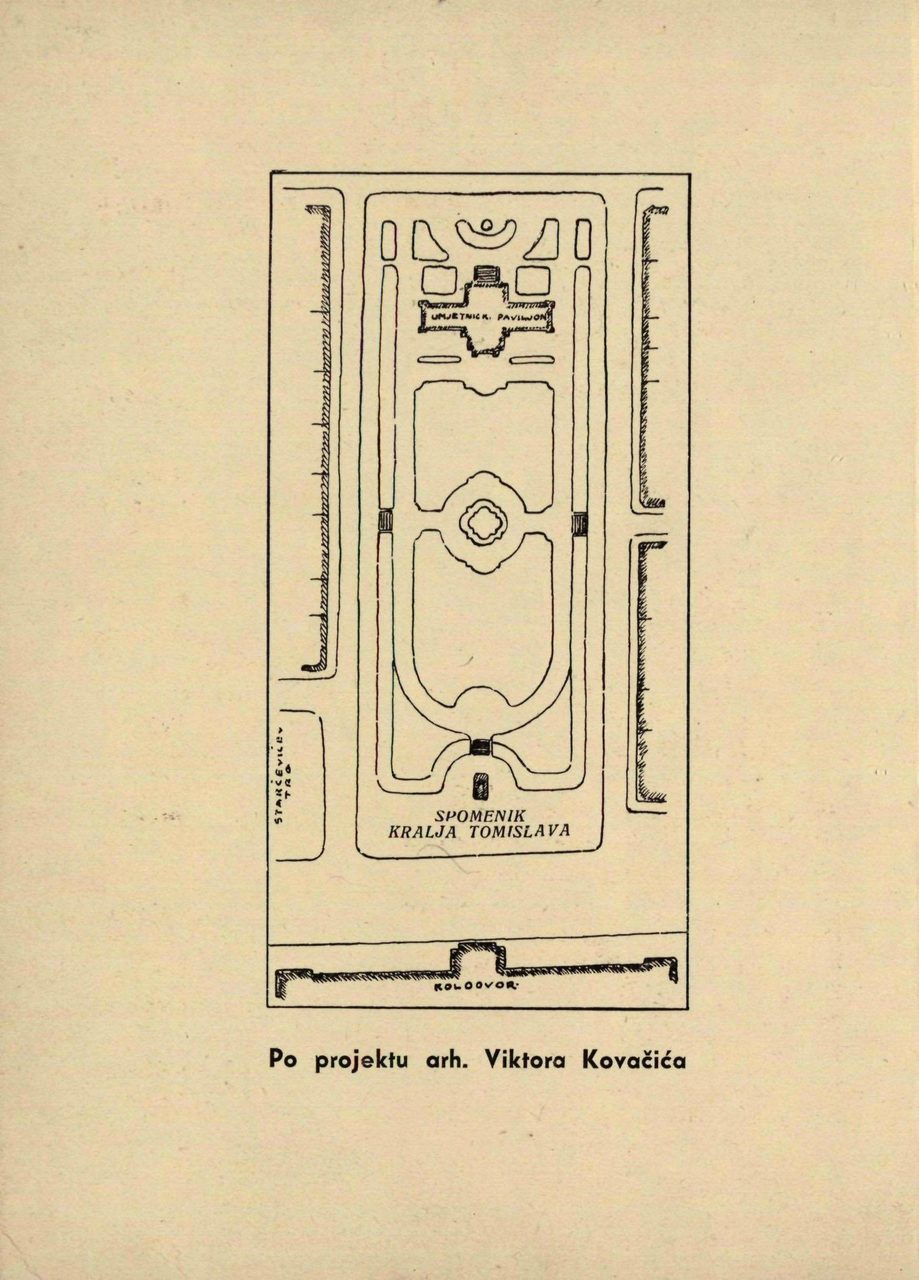
SSince at the beginning cash contributions of other cities, of ad hoc ceremonies and individuals had been high, it seemed that the monument would be put up in quick time, but conditions started changing rapidly. With less pomp than in previous years, in 1930 Robert Frangeš Mihanović finished a plaster model that now needed casting in bronze, and then there was the plinth to make. For the casting, King Aleksandar I donated 5000 kg of cannon bronze, which, with the funds already collected, would be enough for the casting. The casting of the 6 metre high monument was carried out in 26 parts by Zvonimir Oblak in his foundry in Savska cesta 170. Although the casting went over budget, the bronze monument was completed in 1933.
King Tomislav Square, according to the project of Viktor Kovačić (ARLIKUM archive)
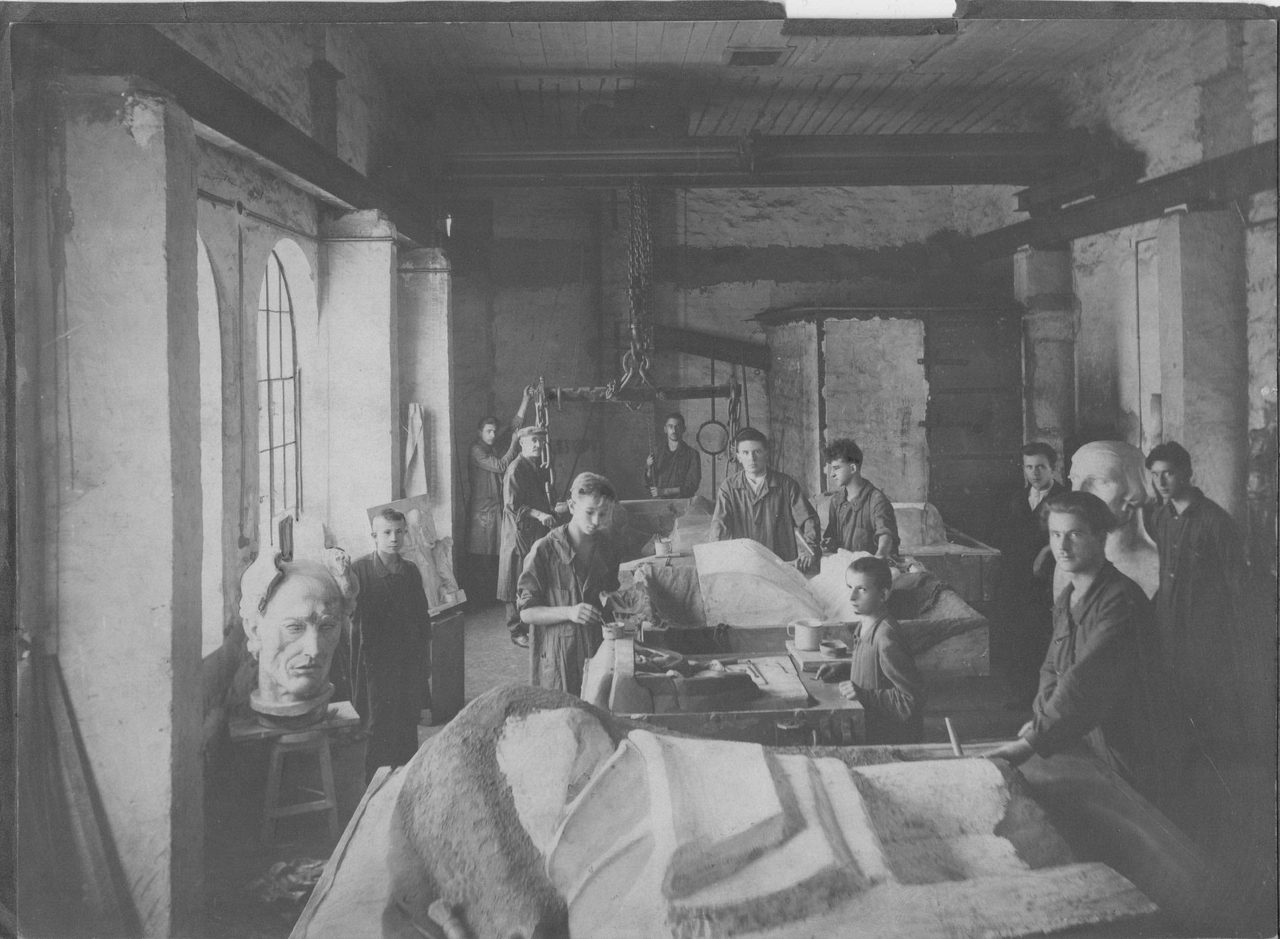
Zvonimir Oblak foundry in Savska street (owner Nives Šoša)

Situation of the designed monument to Francis Joseph I, Viktor Kovačić, watercolor, pencil, pastel (ZC-1218)

Cover of the exhibition catalog of Robert Frangeš Mihanović, 1935 (ARLIKUM)
1935-1940
In 1935 it was put on show in the artist’s studio at Rokov perivoj, where it was seen by about 3500 people. At that moment, all that was missing for the erection was the plinth, and it seemed that the venture was nearing fulfilment, but the real complications were only now to start.
First in 1938 the position at which to raise the monument was called in question, with suggestions that it be placed in the centre of the square, or even in Svačić Square. Milan Dečak several times invoked the design of Viktor Kovačić, which had placed the Franz Joseph I monument in the southern part of the square, pointing out that it was a large monument that ought to be able to be seen from Starčević Square and Mihanović Street as well. The idea of founding a Millennium Museum was brought up again, now to be put in the Art Pavilion, and the square would be laid out in such a way as to have the statue Croatie in the centre. In this way a Forum Croatorum was being devised, to be a kind of space in commemoration of the Croatian people. The square was to be surrounded by monuments to distinguished Croats, with the statue Croatie as the central figure, flanked on the north by the Millennium Museum and on the south by the Tomislav Monument.

Plaster model of the King Tomislav monument, 1930 (photo library of the CASA Glyptotheque)
Nevertheless, on October 21, 1939, the city authority issued a building license saying that the monument had to be placed on a semicircular expansion of the corridor opposite the building of the Main Railway Station, on condition the place be enlarged and reinforced.
The main opponent of the placing of the monument and the Forum Croatorum was the Society of Zagreb People, which stood out against the plan, pointing at the same time to the one-time plan of Ivan Meštrović, which would have put in the same place a monumental arch of triumph to victory and a monument to Aleksandar Karađorđević.
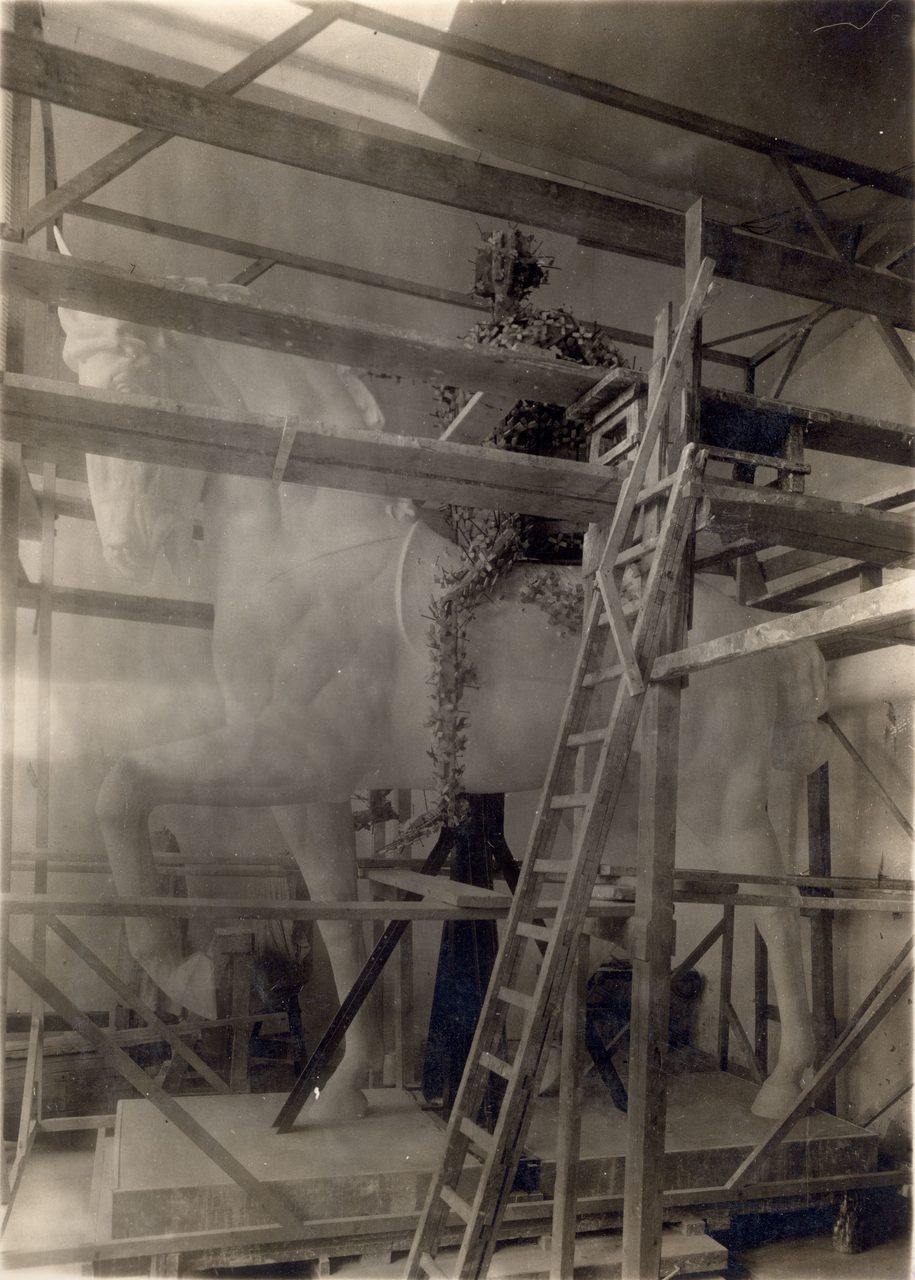
Plaster model of the King Tomislav monument (ARLIKUM photo library)
But it was not only the placing of the monument that caused problems, for there was also the question of which way it was to face. In Frangeš Mihanović’s concept of the Forum Croatorum it was to be turned to the north, i.e., to the figure of Croatie. Along with the Society of Zagreb People, another big opponent of the monument was the director of the Office of the Conservator, Gjuro Szabo, who disputed the artistic value of Frangeš Mihanović’s work, pronouncing it a theatrical failure and an eyesore in the city of Zagreb. He suggested it should be put up in the square in front of the Esplanade Hotel, where in his words the faults of the monument would be concealed. The numerous criticisms and heated discussions about the placing of the sculpture and the general social and political climate as well gradually led to the abandoning of the idea of the Forum Croatorum.
1940-1947
After the death of Frangeš Mihanović on January 12, 1940, the architect Bauer went on with work on the plan for building a plinth, to much criticism and complaining from the public. Not only was the position of the sculpture discussed, but there was also talk of how original he work was, the paper Večer claiming that the Frangeš Mihanović monument was a plagiarism of the Budapest monument to King Stephen by the artist Barnabas Buzy, although the Frangeš Mihanović work actually predated it. In 1940 the government finally decided that the monument was to be placed in its current site, although there were renewed attempts to change the decision. Although the plinth was completed in 1942, the monument was still not placed on it, and in 1945 a Partisan five-pointed star was put in its place.
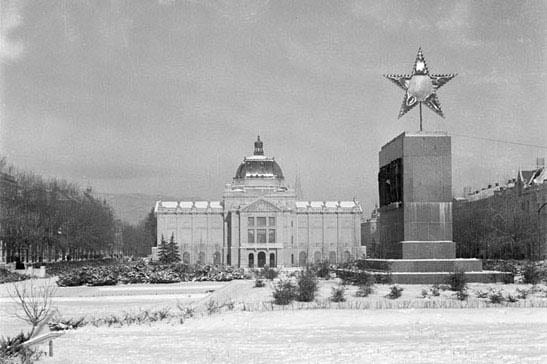
Five-pointed star on a pedestal for the King Tomislav monument, 1945 (postcard)
Erection of the King Tomislav monument, 1947 (archive of the CASA Glyptotheque)
Erection of the King Tomislav monument, 1947 (archive of the CASA Glyptotheque)

Erection of the King Tomislav monument, 1947 (archive of the CASA Glyptotheque)
In October 1947 the monument to King Tomislav was finally put in its place, facing the south. Only one of Frangeš’s reliefs was put with it, and that was soon replaced by reliefs of I. Sabolić and Ž. Janeš. On the southern side of the dais was the inscription:
Tomislav, the first among Croatian rulers, united his tribes in a single state, and was in the year CMXXV proclaimed king. He ruled from the Drava to the Adriatic, over the cities of Split, Zadar, Trogir and over the islands of Krk and Rab, Vis, Brač and Korčula. He waged victorious war in Pannonia, on the Drava and in Apulia. Like Ljudevit Posavski a hundred years previously in the fight against the Franks, Tomislav too operated in an alliance with the Serbs, symbolically sensing the unity of the South Slav peoples.
It was not until 1991 that the original Frangeš reliefs were restored to the plinth, and the inscription on the south was removed, a Croatian coat of arms being put in its place. More than half a century after it was created, the monument at last got its long-since planned appearance.
King Tomislav Monument today (photo by Marko Jandrić)
King Tomislav Monument today (photo by Marko Jandrić)
The last intervention on the monument came in 2001, when the sculpture, reliefs and plinth were inspected in detail and restored.